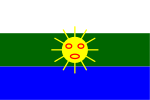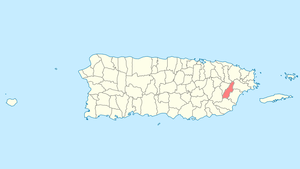Las Piedras, Puerto Rico
Las Piedras (Spanish pronunciation: [las ˈpjeðɾas]) is a municipality in east Puerto Rico (U.S.) located in the center region of the island, north of Yabucoa; south of Canóvanas and Río Grande; east of Juncos and San Lorenzo; and west of Naguabo and Humacao. Las Piedras is spread over 7 wards and Las Piedras Pueblo (the downtown area and the administrative center of the city). It is part of the San Juan-Caguas-Guaynabo Metropolitan Statistical Area.
Las Piedras Municipio de Las Piedras | |
|---|---|
Town and Municipality | |
.jpg) View from Collores, Las Piedras | |
 Flag | |
| Nickname(s): "La Ciudad de los Artesanos" | |
| Anthem: "Somos de la Ribera" | |
 Map of Puerto Rico highlighting Las Piedras Municipality | |
| Coordinates: 18°10′59″N 65°51′59″W | |
| Commonwealth | |
| Founded | 1793 |
| Wards | |
| Government | |
| • Mayor | Miguel "Micky" López (PNP) |
| • Senatorial dist. | 7 - Humacao |
| • Representative dist. | 35 |
| Area | |
| • Total | 33.89 sq mi (87.8 km2) |
| • Land | 33.88 sq mi (87.7 km2) |
| • Water | .01 sq mi (0.03 km2) |
| Population (2010) | |
| • Total | 38,675 |
| • Density | 1,141.5/sq mi (440.7/km2) |
| Demonym(s) | Pedreños |
| Time zone | UTC-4 (AST) |
| ZIP Code | 00771 |
| Area code(s) | 787/939 |
| Major routes | |
Las Piedras has many natural attractions such as La Cueva del Indio which is a place that has original Indian playgrounds, caves and paintings that denote some characteristics of the ancient island's natives. Las Piedras is located about 45 minutes from San Juan, Puerto Rico's capital and 5 minutes from Palmas del Mar, Humacao which is one of the biggest resorts in the Caribbean.
History
Las Piedras was founded in 1793.
When after the Treaty of Paris (1898), the U.S. conducted its first census of Puerto Rico, it was called Piedras and its population was 8,602.[1]
Hurricane Maria
Hurricane Maria on September 20, 2017 triggered numerous landslides in Las Piedras with the significant amount of rainfall.[2][3]
Geography
Las Piedras is on the eastern side of Puerto Rico but not on the coast. According to the 2010 U.S. Census Bureau, the municipality has a total area of 33.89 square miles (87.8 km2), of which 33.88 square miles (87.7 km2) is land and .01 square miles (0.026 km2) is water.[4]
Barrios
Like all municipalities of Puerto Rico, Las Piedras is subdivided into barrios. The municipal buildings, central square and large Catholic church are located near the center of the municipality, in a small barrio referred to as "el pueblo".[5][6][7][8]
Sectors
Barrios (which are like minor civil divisions)[9] in turn are further subdivided into smaller local populated place areas/units called sectores (sectors in English). The types of sectores may vary, from normally sector to urbanización to reparto to barriada to residencial, among others.[10][11][12]
Special Communities
Of the 742 places on the list of Comunidades Especiales de Puerto Rico, the following barrios, communities, sectors, or neighborhoods were in Las Piedras: Quebrada Grande neighborhood, Rivera neighborhood (Hoyo Gardens), Boquerón, Cinco Cuerdas, El Cerrito, Fondo del Saco, Lijas and Pueblito del Río.[13][14]
Demographics
| Historical population | |||
|---|---|---|---|
| Census | Pop. | %± | |
| 1900 | 8,602 | — | |
| 1920 | 10,620 | — | |
| 1930 | 12,907 | 21.5% | |
| 1940 | 15,389 | 19.2% | |
| 1950 | 16,208 | 5.3% | |
| 1960 | 17,047 | 5.2% | |
| 1970 | 18,112 | 6.2% | |
| 1980 | 22,412 | 23.7% | |
| 1990 | 27,896 | 24.5% | |
| 2000 | 34,485 | 23.6% | |
| 2010 | 38,675 | 12.2% | |
| U.S. Decennial Census[15] 1899 (shown as 1900)[16] 1910-1930[17] 1930-1950[18] 1960-2000[19] 2010[7] | |||
Tourism
Landmarks and places of interest
- La Cueva del Indio (Indian Cavern)
- Monte del Retiro (Settlement)
- Artesanial Walk
- Francisco Negrón Park
- Las Piedras Historic Museum
- Panoramic Route 917
Economy
Industry
- Manufacturing: computers and pharmaceutical.
Culture
Festivals and events
Las Piedras celebrates its patron saint festival in December. The Fiestas Patronales Nuestra Señora de Asunción is a religious and cultural celebration that generally features parades, games, artisans, amusement rides, regional food, and live entertainment.[4]
Other festivals and events celebrated in Las Piedras include:
Government
Like all municipalities in Puerto Rico, Las Piedras is administered by a mayor. The current mayor is Mickey Lopez, from the New Progressive Party (PNP). Lopez was elected at the Puerto Rican general election, 2008 -present general election.
The city belongs to the Puerto Rico Senatorial district VII, which is represented by two Senators. In 2012, Jorge Suárez and José Luis Dalmau were elected as District Senators.[21]
Transportation
There are 24 bridges in Las Piedras.[22]
Symbols
Flag
The flag of Las Piedras has three horizontal stripes of equal width, the stripe at the top is colored white, the center stripe is colored green and the bottom stripe is colored blue. In the middle of the flag rests an image of the Taíno sun in yellow.
Coat of arms
In a silver field resides a blue monogram of the Holy Virgin, topped by a blue crown. Seven silver stones border the silver field and at the tip of the shield resides the Taíno sun in gold denominated as the "Sun of Las Piedras".
Notable natives
- Angel López - Singer from the acclaimed and famous worldwide group, Son By Four.
- Luis “El Artesano" Cruz - Professional Boxer.
- Yariel Morales Rivera - Mr. Puerto Rico 2015. Professional model and the only Mr. Puerto Rico (in history) from Las Piedras.
- Margaro Rivera Guzmán-Scholar, attorney and prominent businessman
- Modesto Castro Dávila - Las Piedras Mayor (1980-1984).
- Rafi Jimenez - Broadcaster
- Juan Velázquez- Farmer and political activist
- Elwood Cruz - Reporter
- Juan Manuel Lebrón - Comedian
- Sotero Gómez Hernández- Puerto Rico House Representative
- Silvia Ricardo - Judge
- Carmen Benítez - Notable teacher
- Celia Mondríguez: elderly people rights advocacy
- Isabelo Rivera - Adjutant general of the Puerto Rico National Guard
- Modesto Velázquez Flores - Prosecutor
- José R. Camacho - Broadcaster.
- Eugenio López - Rancher, Boxer.
- Zenón Hernández - Writer, poet.
- Francisco Negrón Díaz - Sport and businessman.
- Miguel Loíz - Teacher, Senator for Humacao district Puerto Rico.
- Miguel Hernández Agosto - Puerto Rico Senate President (1988-1992).
- Víctor Santana Pérez - Teacher, historian, writer and planner of Monte del Retiro.
- Tomas Diaz - Clay Artisan.
- Cano Diaz - Creator of the now famous "Stringed Hammocs".
- Wilfredo Ramos Vázquez-Attorney, philosopher, poverty rights advocacy, public defender, Artificial Intelligence researcher
- Juan Rosa Martínez: first elected mayor of Las Piedras, businessman and sindicalist
- Nicky Cruz-evangelist, reformed gang leader, author of bestselling book, "Run Baby Run". David Wilkerson based his best selling book "The Cross and the Switchblade" in part in Nicky's life
See also
- List of Puerto Ricans
- History of Puerto Rico
- Did you know-Puerto Rico?
References
- Joseph Prentiss Sanger; Henry Gannett; Walter Francis Willcox (1900). Informe sobre el censo de Puerto Rico, 1899, United States. War Dept. Porto Rico Census Office (in Spanish). Imprenta del gobierno. p. 163. Archived from the original on 2012-11-15. Retrieved 2020-03-13.
- "Preliminary Locations of Landslide Impacts from Hurricane Maria, Puerto Rico". USGS Landslide Hazards Program. USGS. Archived from the original on 2019-03-03. Retrieved 2019-03-03.
- "Preliminary Locations of Landslide Impacts from Hurricane Maria, Puerto Rico" (PDF). USGS Landslide Hazards Program. USGS. Archived (PDF) from the original on 2019-03-03. Retrieved 2019-03-03.
- "Las Piedras Municipality". enciclopediapr.org. Fundación Puertorriqueña de las Humanidades (FPH).
- Picó, Rafael; Buitrago de Santiago, Zayda; Berrios, Hector H. Nueva geografía de Puerto Rico: física, económica, y social, por Rafael Picó. Con la colaboración de Zayda Buitrago de Santiago y Héctor H. Berrios. San Juan Editorial Universitaria, Universidad de Puerto Rico,1969. Archived from the original on 2018-12-26. Retrieved 2018-12-31.
- Gwillim Law (20 May 2015). Administrative Subdivisions of Countries: A Comprehensive World Reference, 1900 through 1998. McFarland. p. 300. ISBN 978-1-4766-0447-3. Retrieved 25 December 2018.
- Puerto Rico:2010:population and housing unit counts.pdf (PDF). U.S. Dept. of Commerce Economics and Statistics Administration U.S. Census Bureau. 2010. Archived (PDF) from the original on 2017-02-20. Retrieved 2018-12-31.
- "Map of Las Piedras at the Wayback Machine" (PDF). Archived from the original (PDF) on 2018-03-24. Retrieved 2018-12-29.
- "US Census Barrio-Pueblo definition". factfinder.com. US Census. Archived from the original on 13 May 2017. Retrieved 5 January 2019.
- "Agencia: Oficina del Coordinador General para el Financiamiento Socioeconómico y la Autogestión (Proposed 2016 Budget)". Puerto Rico Budgets (in Spanish). Archived from the original on 28 June 2019. Retrieved 28 June 2019.
- Rivera Quintero, Marcia (2014), El vuelo de la esperanza: Proyecto de las Comunidades Especiales Puerto Rico, 1997-2004 (first ed.), San Juan, Puerto Rico Fundación Sila M. Calderón, ISBN 978-0-9820806-1-0
- "Leyes del 2001". Lex Juris Puerto Rico (in Spanish). Archived from the original on 14 September 2018. Retrieved 24 June 2020.
- Rivera Quintero, Marcia (2014), El vuelo de la esperanza: Proyecto de las Comunidades Especiales Puerto Rico, 1997-2004 (1st ed.), San Juan, Puerto Rico Fundación Sila M. Calderón, p. 273, ISBN 978-0-9820806-1-0
- "Comunidades Especiales de Puerto Rico" (in Spanish). 8 August 2011. Archived from the original on 24 June 2019. Retrieved 24 June 2019.
- "U.S. Decennial Census". United States Census Bureau. Archived from the original on February 13, 2020. Retrieved September 21, 2017.
- "Report of the Census of Porto Rico 1899". War Department Office Director Census of Porto Rico. Archived from the original on July 16, 2017. Retrieved September 21, 2017.
- "Table 3-Population of Municipalities: 1930 1920 and 1910" (PDF). United States Census Bureau. Archived (PDF) from the original on August 17, 2017. Retrieved September 21, 2017.
- "Table 4-Area and Population of Municipalities Urban and Rural: 1930 to 1950" (PDF). United States Census Bureau. Archived (PDF) from the original on August 30, 2015. Retrieved September 21, 2014.
- "Table 2 Population and Housing Units: 1960 to 2000" (PDF). United States Census Bureau. Archived (PDF) from the original on July 24, 2017. Retrieved September 21, 2017.
- "Puerto Rico Festivales, Eventos y Actividades en Puerto Rico". Puerto Rico Hoteles y Paradores (in Spanish). Archived from the original on 2020-02-26. Retrieved 2020-07-17.
- Elecciones Generales 2012: Escrutinio General Archived 2013-01-15 at the Wayback Machine on CEEPUR
- "Las Piedras Bridges". National Bridge Inventory Data. US Dept. of Transportation. Archived from the original on 21 February 2019. Retrieved 20 February 2019.